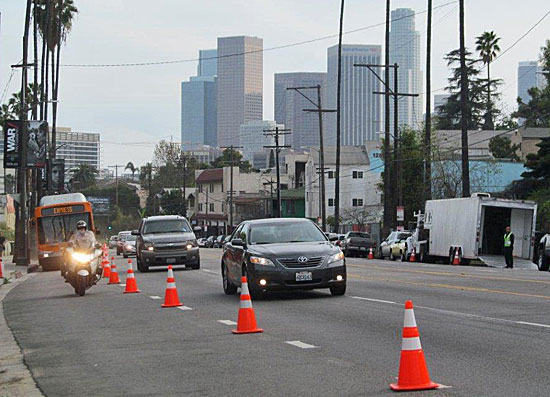Trying to beat Dodger traffic blues
April 4, 2013
Every spring, it happens like clockwork: Vin Scully’s voice lilts across the metropolis, Dodger dogs become an essential food group and downtown L.A. resigns itself to 80-plus nights of traffic headaches.
This year, though, there’s an upstart rookie in town: a 1.5-mile dedicated Dodger Stadium Express bus lane running along Sunset Boulevard, aiming to revolutionize how the getting-to-the-stadium game is played.
With the Dodgers under new management and the stadium freshly spiffed up with a $100 million renovation, aggressive efforts are underway to crack one of L.A.’s thorniest traffic dilemmas—getting fans into and out of Chavez Ravine when most home games overlap with downtown’s always lively afternoon rush hour.
“There’s no room for error,” said Aram Sahakian of the city Department of Transportation’s special traffic operations division. For the home opener Monday, “we threw everything we had at it.”
It paid off on the first day, he said: “I don’t think ever in Dodgers history we’ve cleared [stadium traffic from] Sunset on Opening Day before the first pitch…It was a huge success.”
But while ridership on the Dodger Stadium Express buses is up—9,750 so far this year, compared to 7,157 at the same time last year—general traffic downtown this week has been, well, foul.
“Obviously, when you take a lane away, it will have an impact,” Sahakian said, “but it’s also driver behavior. There’s some tweaking to be done.”
The new lane on Sunset, while a boon to game-goers who ride the express buses, is clearly confounding some drivers.
“It’s new to motorists; they don’t know what it is,” Sahakian said of the dedicated lane, which begins at Figueroa and runs through Elysian Park to the stadium.
Those used to driving in the curbside space now taken up by the new, 12-foot-wide bus lane will need to adjust by changing their lane choice, or their route, he said. And those headed to the game by car should give some serious thought to taking the bus next time. (The buses depart from Union Station at 10-minute intervals before each game, and every 30 minutes while the game is in progress.)
Other adjustments also are in the works. Sahakian is proposing that the city’s Automated Traffic Surveillance and Control system be up and running for all home games, as it was on Opening Day, so real-time adjustments can be made to traffic signals. Sahakian also is suggesting that cars carrying four or more people be allowed to use the special lane.
“We’re brainstorming,” he said. “It’s a challenge. The venue, the location, is a challenge for us.”
This year, enthusiasm about the team and its new owners means likely higher attendance, with 20 games already sold out, Sahakian said. And that means heavier traffic.
“We know attendance is going to be very high. We’re excited about it, but with that comes challenges.”
Renata Simril, the Dodgers’ senior vice president for external affairs, said the organization is heavily promoting Dodger Express bus ridership and the new dedicated lane, including on Scully’s popular broadcasts.
She said the Dodgers have also made adjustments to make it quicker for motorists to get into the stadium parking lots. “Ambassadors” now walk down lines of waiting cars to accept parking payment. (They’re still accepting cash only, but by next season should be equipped with mobile devices that will allow them to take credit cards.)
In addition, the ballpark is opening half an hour earlier before games—at 4:30 p.m. for a 7:10 p.m. start.
“Every little bit helps,” Simril said. “We’re trying to take a multi-pronged approach.”
The Dodger Express buses, which are free to riders with a game ticket and $1.50 each way for other passengers, run on clean-burning compressed natural gas and are funded by a two-year, $1.1 million grant from a regional air pollution reduction committee.
City officials and the Dodgers are hoping that increasing express bus ridership will reduce the number of cars coming into the stadium, and the dedicated lane on Sunset is seen as an important tool in persuading people to hop aboard.
“Taking one lane away is going to impact people driving to the stadium,” Sahakian acknowledged, “but at the same time, you’re incentivizing mass transit.”
Looking at the long-term picture, though, Sahakian thinks a bolder solution may be called for.
“My personal recommendation,” he said, “would be a monorail.”
Posted 4/4/13














 405 bridge work causes a stink
405 bridge work causes a stink

